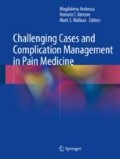Abstract
Opioids are one of the few drugs that lead to extreme dependence and will result in severe withdrawal symptoms upon abrupt cessation. The chronic use of opioids result in physiological changes within the central nervous system leading to dependence, withdrawal syndrome, and addiction. Many patient consuming chronic opioids to treat chronic pain desire to stop them but rather continue them in order to avoid the severe withdrawal syndrome. However, there are accepted methods of discontinuing opioids that if carefully done will avoid the withdrawal syndrome. These methods include a slow taper with the use of adjuvants to treat withdrawal side effects, outpatient Suboxone detoxification, or inpatient detoxification for selected patients. The method used will be determined by patient factors such as compliance, psychosocial factors, and level of chronic pain.
Access this chapter
Tax calculation will be finalised at checkout
Purchases are for personal use only
References
Kosten TR, George TP. The neurobiology of opioid dependence: implications for treatment. Sci Pract Perspect. 2002;1(1):13–20.
Ouyang H, Liu S, Zeng W, Levitt RC, Candiotti KA, Hao S. An emerging new paradigm in opioid withdrawal: a critical role for glia-neuron signaling in the periaqueductal gray. ScientificWorldJournal. 2012;2012:940613.
Pasternak GW. Molecular biology of opioid analgesia. J Pain Symptom Manag. 2005;29(5 Suppl):S2–9.
Yaksh TL, Wallace MS. Opioids, analgesia and pain management. In: Brunton L, Chabner B, Knollman B, editors. Goodman and Gilman’s the pharmacological basis of therapeutics, vol. 12. New York: McGraw-Hill; 2011. p. 481–525.
Koob GF, Le Moal M. Drug addiction, dysregulation of reward, and allostasis. Neuropsychopharmacology. 2001;24(2):97–129.
Hamilton RJ, Olmedo RE, Shah S, et al. Complications of ultrarapid opioid detoxification with subcutaneous naltrexone pellets. Acad Emerg Med. 2002;9(1):63–8.
American Psychiatric Association. Diagnostic and statistical manual of mental disorders (DSM-5®). American Psychiatric Pub; 2013.
Wesson DR, Ling W. The clinical opiate withdrawal scale (COWS). J Psychoactive Drugs. 2003;35(2):253–9.
Handelsman L, Cochrane KJ, Aronson MJ, Ness R, Rubinstein KJ, Kanof PD. Two new rating scales for opiate withdrawal. Am J Drug Alcohol Abuse. 1987;13(3):293–308.
Srivastava A, Kahan M. Buprenorphine: a potential new treatment option for opioid dependence. CMAJ. 2006;174(13):1835.
Molassiotis A, Uyterlinde W, Hollen PJ, Sarna L, Palmer P, Krishnasamy M. Supportive care in lung cancer: milestones over the past 40 years. J Thorac Oncol. 2015;10(1):10–8.
Center for Substance Abuse Treatment. Clinical guidelines for the use of buprenorphine in the treatment of opioid addiction. DHHS Publication No. (SMA) 04-3939 ed. Rockville: Substance Abuse and Mental Health Services Administration; 2004.
Patwardhan AG, Rathmell J, Viscomi CM, Bernstein IM. Managing pain during pregnancy and lactation. In: Staats P, Wallace MS, editors. Pain medicine and management: just the facts, vol. 2. New York: McGraw-Hill; 2015. p. 316–24.
Author information
Authors and Affiliations
Corresponding author
Editor information
Editors and Affiliations
Rights and permissions
Copyright information
© 2018 Springer International Publishing AG
About this chapter
Cite this chapter
Wallace, M.S., Papp, A. (2018). Opioid Withdrawal. In: Anitescu, M., Benzon, H., Wallace, M. (eds) Challenging Cases and Complication Management in Pain Medicine. Springer, Cham. https://doi.org/10.1007/978-3-319-60072-7_3
Download citation
DOI: https://doi.org/10.1007/978-3-319-60072-7_3
Published:
Publisher Name: Springer, Cham
Print ISBN: 978-3-319-60070-3
Online ISBN: 978-3-319-60072-7
eBook Packages: MedicineMedicine (R0)

